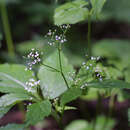Comprehensive Description
provided by North American Flora
Cryptotaenia canadensis (L.) DC. Prodr. 4: 119. 1830
Sison canadense L. Sp. PL 252. 1753.
Chaerophyllum canadense Crantz, Class. Umbell 79. 1767.
Sium canadense Lam. Encyc. 1: 407. 1785.
Myrrhis canadensis Gaertn. Fruct. 1: 109. 1788.
Cicuta perennans Walt. Fl. Car. 116. 1788.
Scandix lemata Moench. Meth. 101. 1794.
Myrrhis ternata Moench. Meth. 101. 1794.
Conopodium canadense Koch, Nova Acta Acad. Leop. -Carol. 12: 119. 1825.
Petagnia saniculaefolia Guss. Fl. Sic. Prodr. 1: 311. 1827.
Cyrtospermum trifoliatum Raf.; DC. Prodr. 4: 119, as syn. 1830.
Mesodiscus simplex Raf. New Fl. 4: 20. 1838.
Mesodiscus proliferus Raf. New. Fl. 4: 20. 1838.
Deeringia canadensis Kuntze, Rev. Gen. 1: 266. 1891. Plants 3-9 dm. high; leaves oblong-ovate in general outline, excluding the petioles 3-13 cm. long, 5-15 cm. broad, the leaflets oblong-lanceolate to obovate, 3-16 cm. long, 3-8 cm. broad, short-acuminate at the apex, cuneate at the base, closely and doubly serrate or occasionally deeply 2-3-lobed; petioles 7-14 cm. long; upper cauline leaves reduced to lanceolate, dentate bracts; rays 2-7, ascending, 1-6 cm. long; pedicels 2-10, ascending, 2-35 mm. long; fruit 3.5-8 mm. long, 1.5-3 mm. broad.
Type locality: "In America septentrionalis," collector unknown.
Distribution: New Brunswick and Quebec to Georgia, west to Manitoba, Nebraska, and
- bibliographic citation
- Albert Charles Smith, Mildred Esther Mathias, Lincoln Constance, Harold William Rickett. 1944-1945. UMBELLALES and CORNALES. North American flora. vol 28B. New York Botanical Garden, New York, NY
Cryptotaenia canadensis: Brief Summary
provided by wikipedia EN
Cryptotaenia canadensis, the Canadian honewort, is a perennial plant species native to the eastern United States and eastern Canada. Its young leaves and stems can be used as a boiled green or seasoning similar to parsley. The parsniplike roots can be cooked and eaten.
- license
- cc-by-sa-3.0
- copyright
- Wikipedia authors and editors

